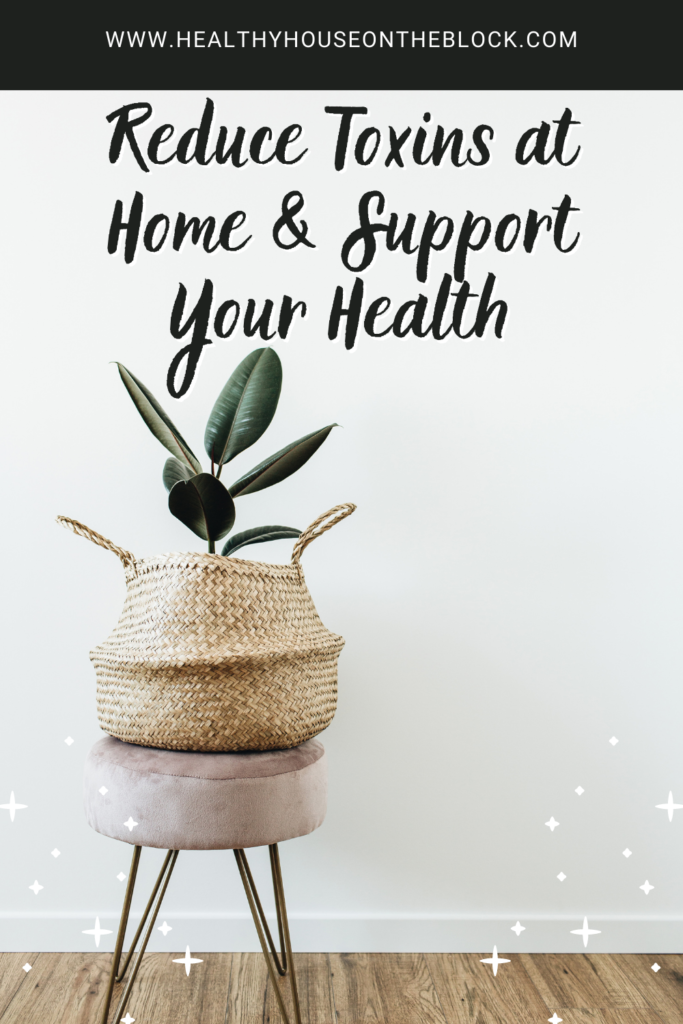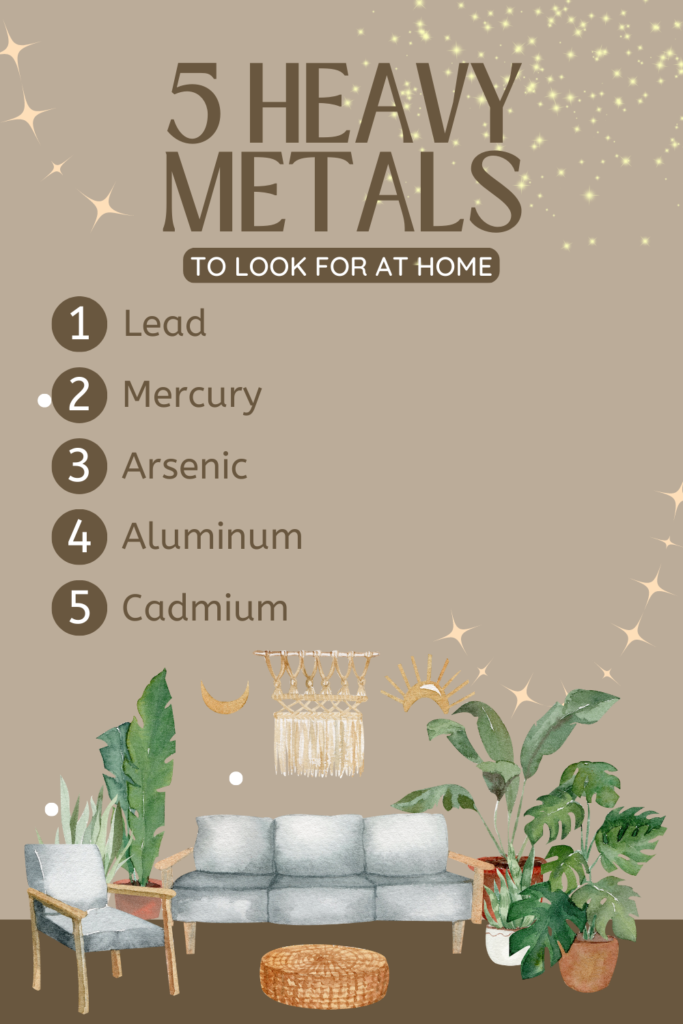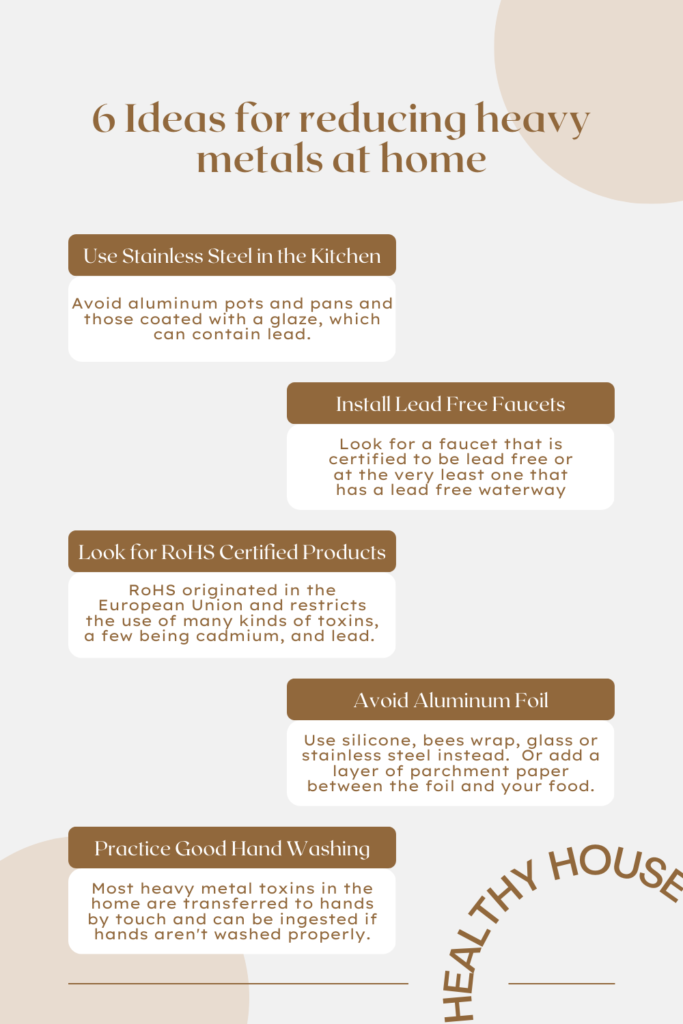
I think many of us think that toxic heavy metals are maybe something only found in old homes or old products, but the truth is that toxic heavy metals are even in materials we use today and purchase today. Heavy metals can oftentimes be forgotten about because we focus so much on the newer toxins like VOCs, flame retardants and formaldehyde.
But the truth is that toxins don’t necessarily stop being used once we know that they are harmful to our health and wellness. In fact, sometimes until a law changes (and even then it’s still a bit iffy), heavy metals and other toxins will continue to be used.
Now before we jump into the good stuff and all the details in this week’s post, I think this one should come with a caveat: PLEASE don’t stress about these toxins. Yes, you may find them in your home and YES, you may have been exposed within your space. But, stress is ONLY going to make the exposure worse.
If you have found toxic heavy metals in your home or in your home items, you can ONLY move forward. Move forward with a sense of appreciation that you did find the toxins in your space, or you’re now learning them. Move forward with the hope of removing as much of these heavy metal toxins as you can. Move forward with confidence that you are empowered with knowledge to make your home toxin free.

TOXIC HEAVY METAL SYMPTOMS & YOUR HEALTH
One of the BIG reasons that people start hunting for heavy metals in their homes is due to their own health. Many of us don’t realize we’ve been exposed to heavy metals UNTIL it shows up in our own health.
Overtime, many toxic heavy metals will build up in your body overtime. This is because our bodies typically do not detox heavy metals very quickly, and so even if you’re being exposed at low levels over time, there can be high levels of heavy metal toxins in your body as your body just CANNOT get rid of it fast enough.
Heavy metals also disrupt the metabolic function in the body. First, they can accumulate and build up within the body, which disrupts the function of vital organs and glands (such as the heart, brain, kidneys, bone or liver). The second way they disrupt is that they replace the vital nutritional minerals we have in our bodies, which in turn hinders their biological function. (RESOURCE)
Heavy metals can disrupt cellular function including growth and the repair process, which can severely damage the cells in various parts of the body. But heavy metals are seen as a HUGE neurotoxin and so their effect on the brain can be one of the most alarming.

DANGEROUS HEAVY METAL EXPOSURE AND KIDS
Because children are SO much smaller than adults, the negative effects on their system can be even greater than what an adult may experience. First and foremost, the amount of exposure to a child is going to negatively affect their body much more than an adult. This is simply because pound for pound, children are smaller than adults, and so the proportion of a toxin is much larger with children.
Another VERY large reason that toxic heavy metals are particularly harmful to children is because of their poor hand to mouth habits. Many heavy metals are exposed only via ingestion. Lead for example won’t be absorbed into the bloodstream via touch and it usually is not inhaled (except for if it is lead paint dust). However, if a child touches an item with lead on the surface, the lead can be on their hands, which they can then put in their mouth or touch food and expose themselves that way.
And then finally, kids have very undeveloped systems. Their bodies are still developing and growing. By disrupting cells that are growing with heavy metals, it can in turn affect them their entire lives, especially developmentally.

HEAVY METALS FOUND IN THE HOME:
While there are a number of toxic heavy metals around, these are the most common toxins that are found in the home:
Lead: Lead is probably the BIGGEST toxin we see in homes today. Lead has been used in everything from paint, to water pipes to hardware fixtures. The older your home the more likely that there’s potentially lead in the home somewhere.
Lead paint was used before 1978, and so if your home is older than 1978 and you see flaking, or chipping paint in your home, it is best to be precautious and call in a professional to remove it.
Lead could potentially be in water pipes in your home if you live in an older house. The most common would be a drain pipe in your home (thankfully NOT a supply line pipe that brings water to a fixture). Lead pipes are often a dull gray pipe, but if it’s scratched with something hard, such as a key, it leaves a very shiny indent. There are two options with lead drain pipes: you can have them removed by a professional who practices lead-safe abatement techniques, or you can leave it alone. Most homeowners choose to leave it alone as it carries water away from a drain and it is never touched by their water coming out of fixtures.
Another consideration is that some solder used on copper pipes or plumbing fixtures can in fact have lead in the solder. If you’re having work done, it doesn’t hurt to have your own lead-free solder on hand or ask your plumber about it.
Lastly, lead can also be found in some hardware. Brass hardware is notorious for having trace amounts of lead in the product. This could be from handles on faucets, it could be door knobs, cabinet pulls and other hardware around your home.
Mercury: Mercury is a colorless, odorless vapor that is extremely toxic. The most common place you’ll find mercury in your home is in lightbulbs that are still available in stores and on lines. Fluorescent lights and compact fluorescent lights contain mercury in them, and so it is VERY important to be aware that if these lightbulbs break, there can be unsafe exposure in your home.
Other home items that might contain mercury are thermostats, thermometers and barometers. And so while this mercury is enclosed, it is important to be aware that if they break, it can be an unsafe exposure within your home.
Older latex paint (pre 1990) also has the potential for containing mercury within the paint, which could be a potential hazard if your home hasn’t been painted since prior to 1990.

Arsenic: Arsenic is most closely correlated with water exposure. Arsenic is naturally occurring in some types of soil, especially soil containing mineral ore. Most arsenic that we’re exposed to will be in our drinking water, which actually can be filtered out with the appropriate filter.
Arsenic used to be found in herbicides used to kill weeds, however that has since been replaced with other chemicals and toxins. It has also been found in pressure treated wood (to help protect the wood from rot and from insects). Specifically, it is found in chromated copper arsenate (CCA). This wood has been used in playgrounds, decks, fences, home foundations and other structures. It’s extremely toxic to breathe in smoke from these burning woods.
Arsenic naturally occurs in other meals such as cobalt, gold, nickel and lead, and so it’s good to be aware of when purchasing items made of these metals.
Arsenic is carcinogenic and has been linked to an increased risk of bladder cancer, skin cancer, lung cancer, kidney cancer and liver cancer. (RESOURCE)
Aluminum: Unfortunately, aluminum ALMOST gets a free pass in the US — so much of what we use in our kitchens contain aluminum. But the truth is that aluminum has been linked to a number of neurological diseases such as Parkinsons and Alzheimers.
Pots and pans can contain a percentage of aluminum in them, even if they appear to be stainless steel. (This post talks all about stainless steel pots and pans and other toxin free options)
Many families also still use aluminum foil, which again, contains toxins. A work around for our family has been placing parchment paper between our food and the foil to prevent any sort of leaching.
Another HUGE source of aluminum is in skincare products, particularly deodorant. This is one of the worst, in my opinion, because oftentimes deodorant is on your skin for almost 24 hours before bathing and washing it off, meaning the exposure time is long.
Cadmium: Most common sources for cadmium are in dyes and pigments, however it has also been detected in batteries, metal coatings and plastics.
However, I think the most common source of cadmium is with ceramics — especially ceramics that are used in the kitchen. A dyed glaze or pigmented ceramic product can contain cadmium, and unfortunately it’s then touching our food.
There can also be cadmium in some groundwater that then travels to your home, which could be another way it is ingested.
The big concern with cadmium is that even with low levels of chronic exposure, it can in fact damage the kidneys and even cause bone disorders like osteoporosis. (SOURCE)

REDUCE HEAVY METAL TOXINS
The good news is there are MANY easy, easy ways to reduce heavy metal toxins within our homes. And they’re not crazy or difficult ways either.
Opt for Stainless Steel in the Kitchen: Because heavy metal toxins are SO easily ingested when they come in contact with our foods, it is extremely important to be aware of what we are cooking and storing our food inside of. 100% Stainless steel is best for the kitchen. Be sure that IF there is aluminum in the pan it is only the CORE of the pan. Aluminum transfers heat very well and so quite often the core may contain aluminum, however the exterior that you’re cooking with is stainless steel.
Another option is a lead free 100% ceramic cookware like Xtrema Pans or a cast iron pan.
Faucets that are Lead Free Certified: Faucets, believe it or not, can contain lead in the finish of the faucet or in the internal parts. I LOVE Kraus Faucets as they are lead free and have a guaranteed lead free waterway, meaning your water doesn’t touch lead as it travels through the faucet.
The best and safest option is going to the a stainless steel faucet as it doesn’t contain a finish on the outside that could potentially contain lead or another heavy metal. I realize this may be an unpopular opinion as it’s not as stylish as an enameled faucet, but it will reduce your potential exposure to lead.
RoHS Certified Products: Another way you can reduce lead exposure at home is by checking the RoHS Certification list. Many types of products are verified on the list, including door knobs and drawer and cabinet pulls. RoHS originated in the European Union and restricts the use of many kinds of toxins, a few being cadmium, and lead.
The certification requires rigorous testing of products that includes microscopic and x-ray technology.
Avoid Aluminum Foil: While we do still use some aluminum as a family, we also add a layer of parchment paper to it in order to reduce exposure and contact with our food. There are many alternatives to use rather than tinfoil in the kitchen: silicone, bees wrap and glass or stainless steel containers.
But if you’re like my family and you want to use aluminum to save cleaning a pan or two, just add that layer of parchment to it.
Practice Hand Washing: MOST of the toxins that I mentioned in this post are toxins that are ingested, therefore, excellent hand washing habits will help reduce these toxins.
A perfect example would be touching a door knob that could potentially have lead in it. While this cannot be absorbed through your skin, if you were to then eat a handful of almonds, you’d be transferring the toxins to the food that you’re eating. This is why it is extremely important for kids to keep clean hands. Kids quite often expose themselves to toxins simply because they have their hands in their mouths more often.
Filtered Water: SO many toxins are in our water that we drink. Even if you get your water filtered through your city or municipality, there are in fact toxins that make their way into your home anyways. And even if they don’t, your plumbing can also leach toxins into your water.
To start off, it’s important to assess your water. I recommend a Tap Score kit to get you started with a full test and understanding of your water. From there, it will be easy to decide if you should get a multistage filter or a reverse osmosis filter. This post can help you work through what type of filter you may need in your home.

Again, I implore you not to stress about these toxins, just move forward with better choices and habits to reduce the exposure to toxic heavy metals in your home.




Pingback: Non Toxic Tile Flooring & Backsplash Tile - Healthy House on the Block